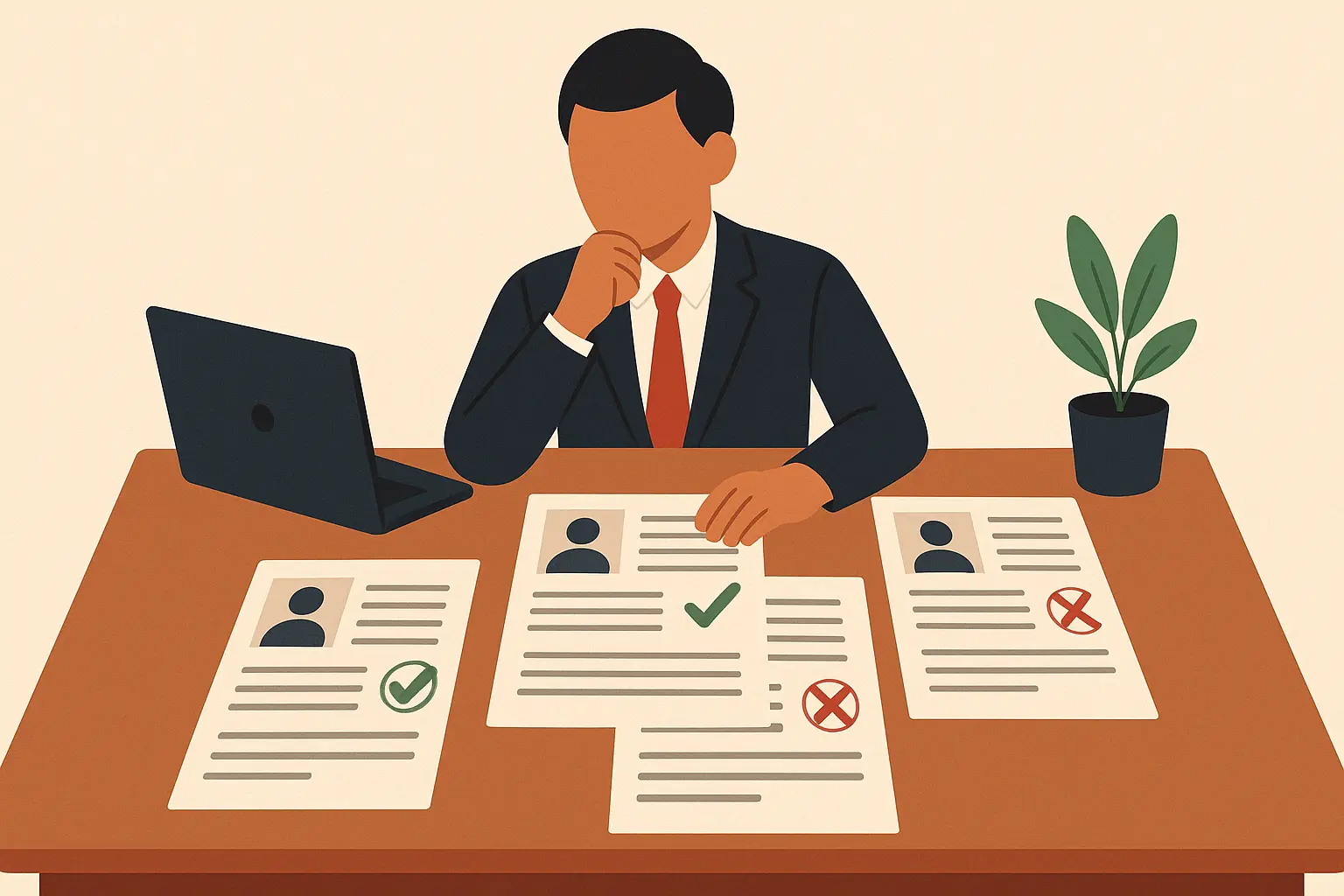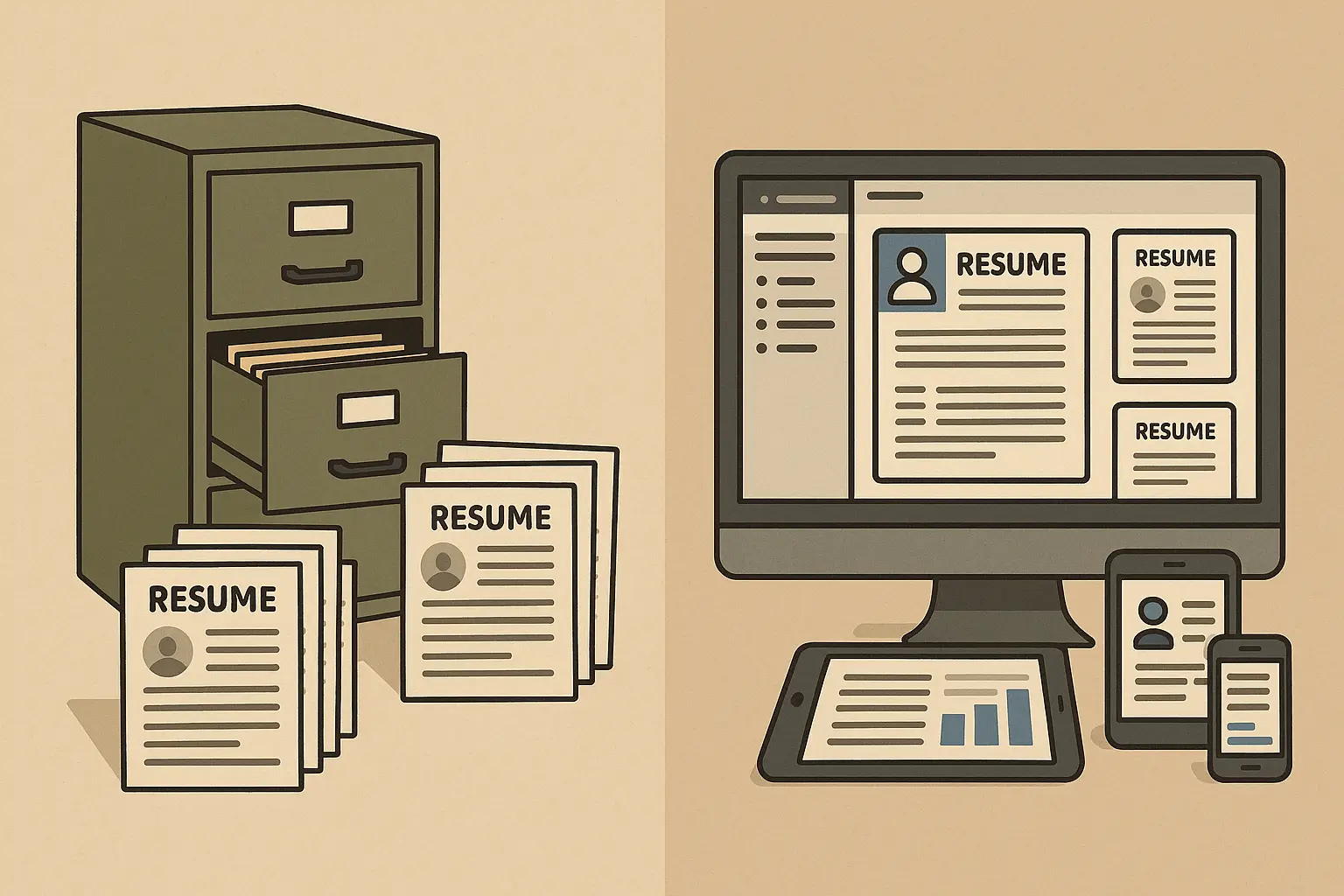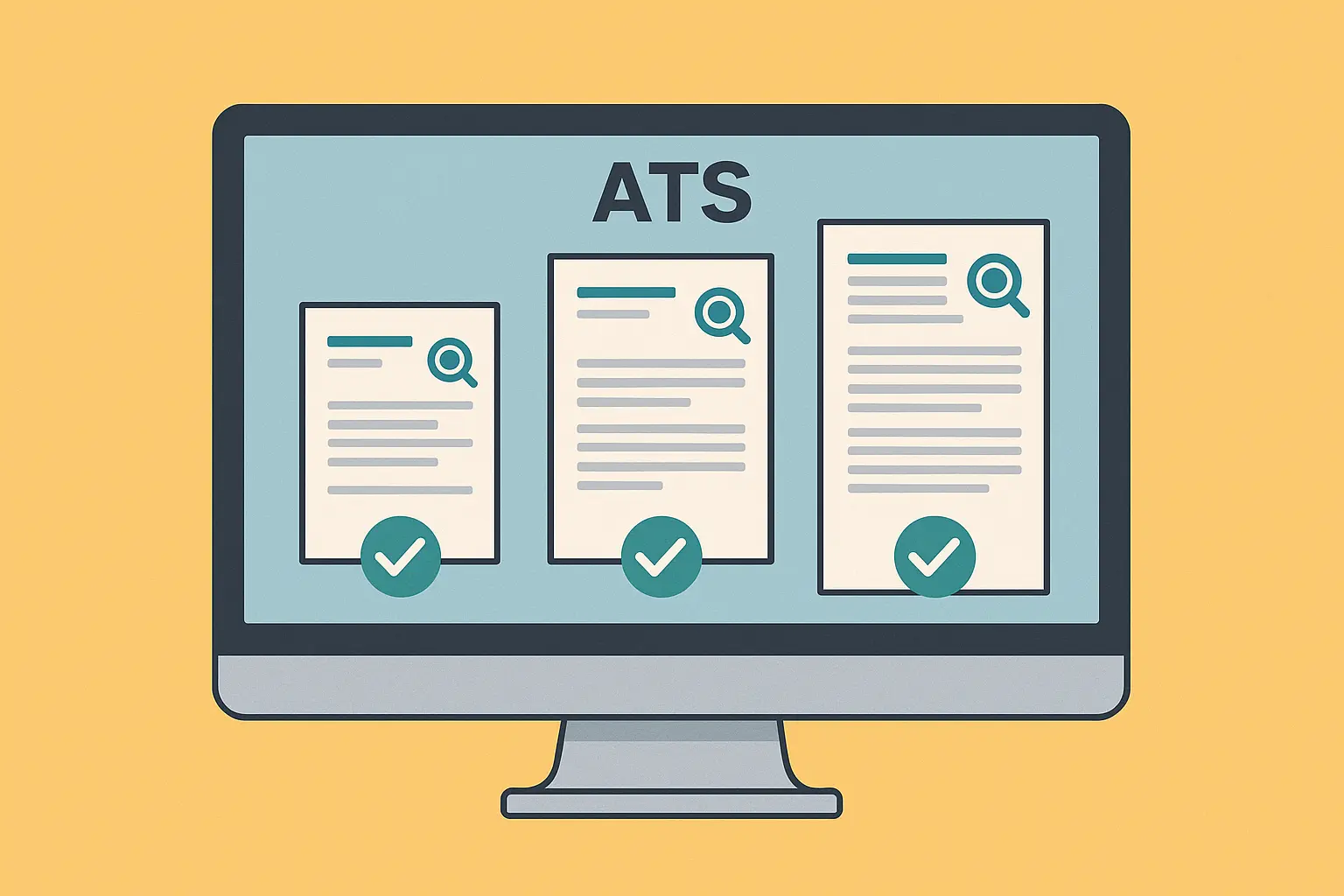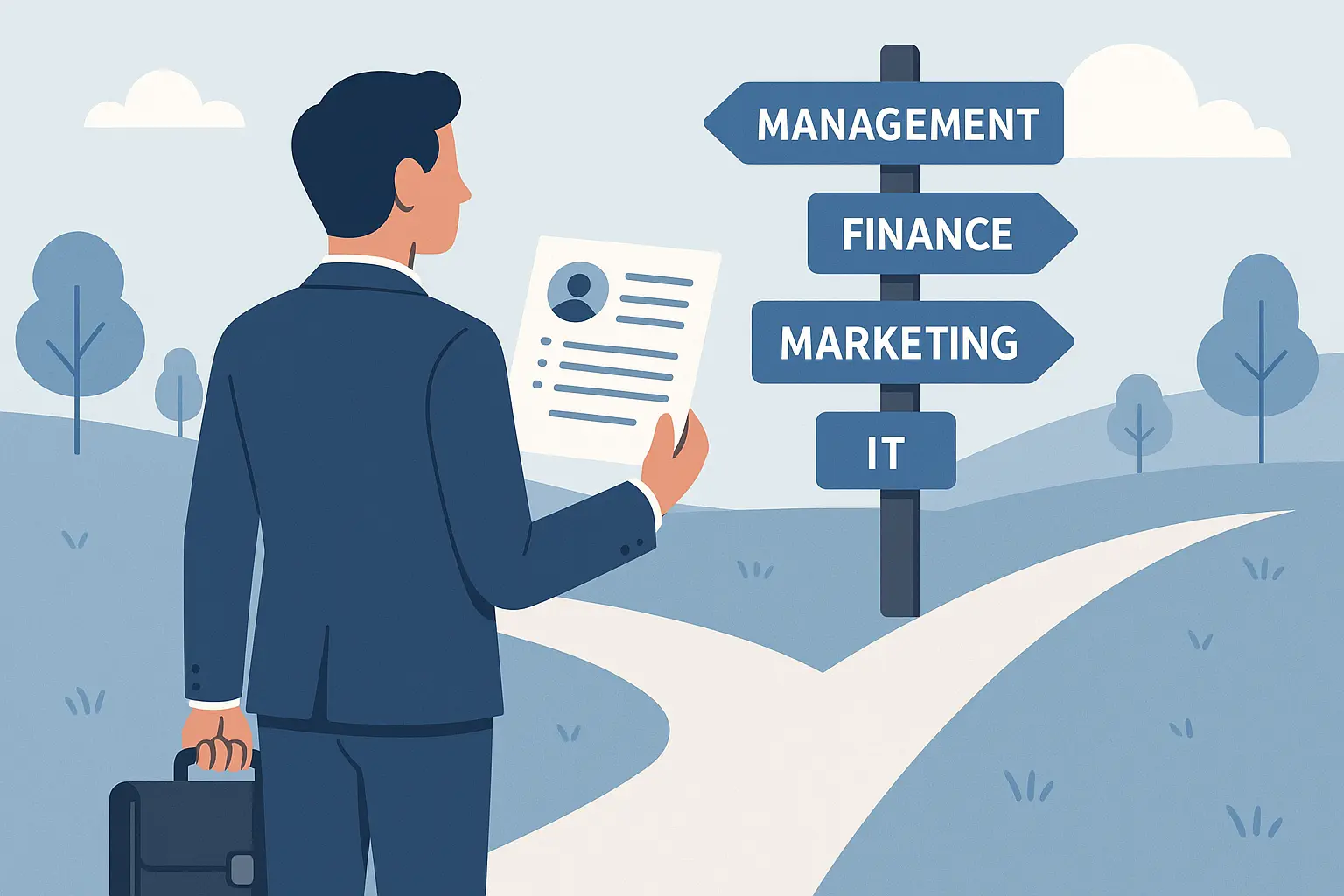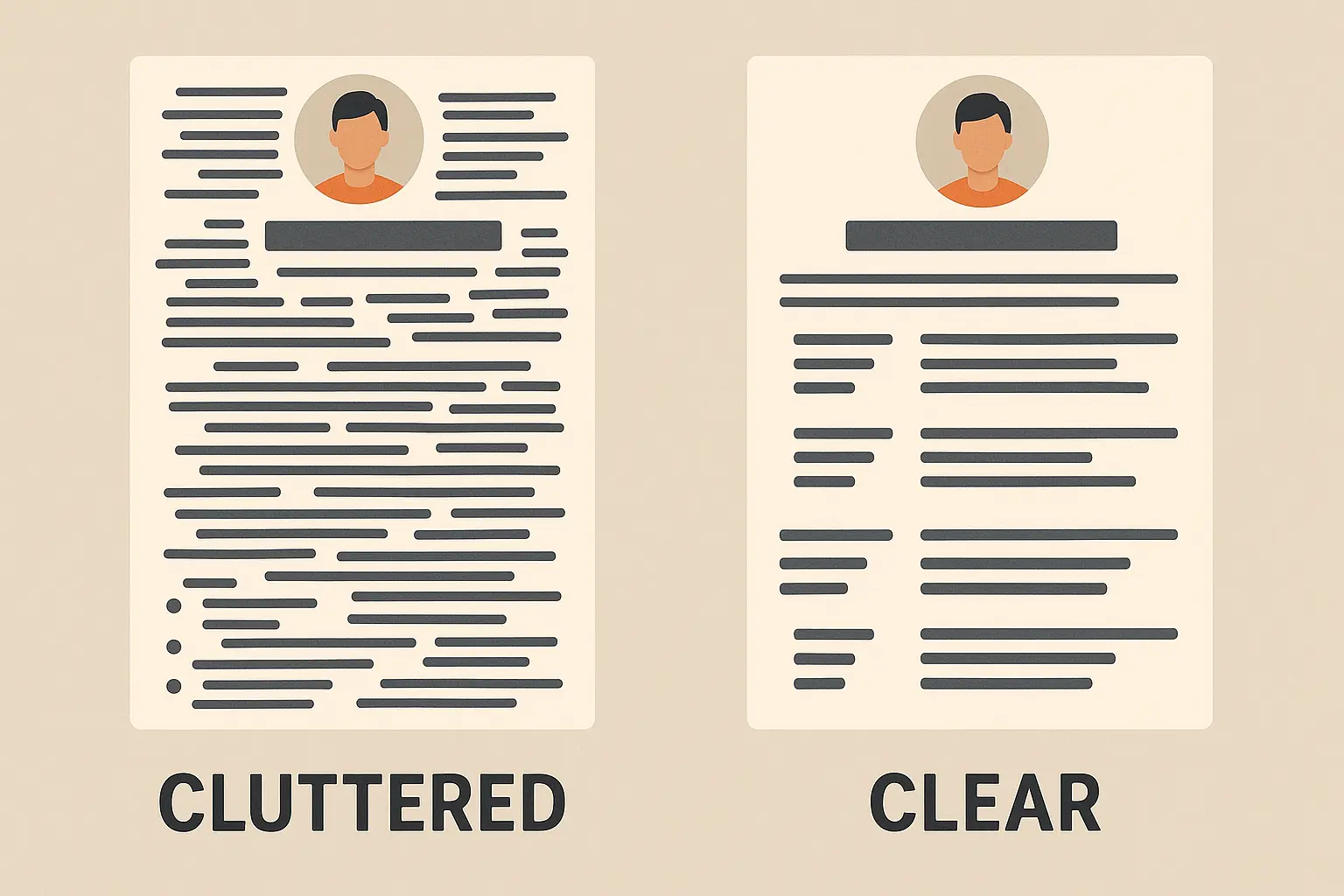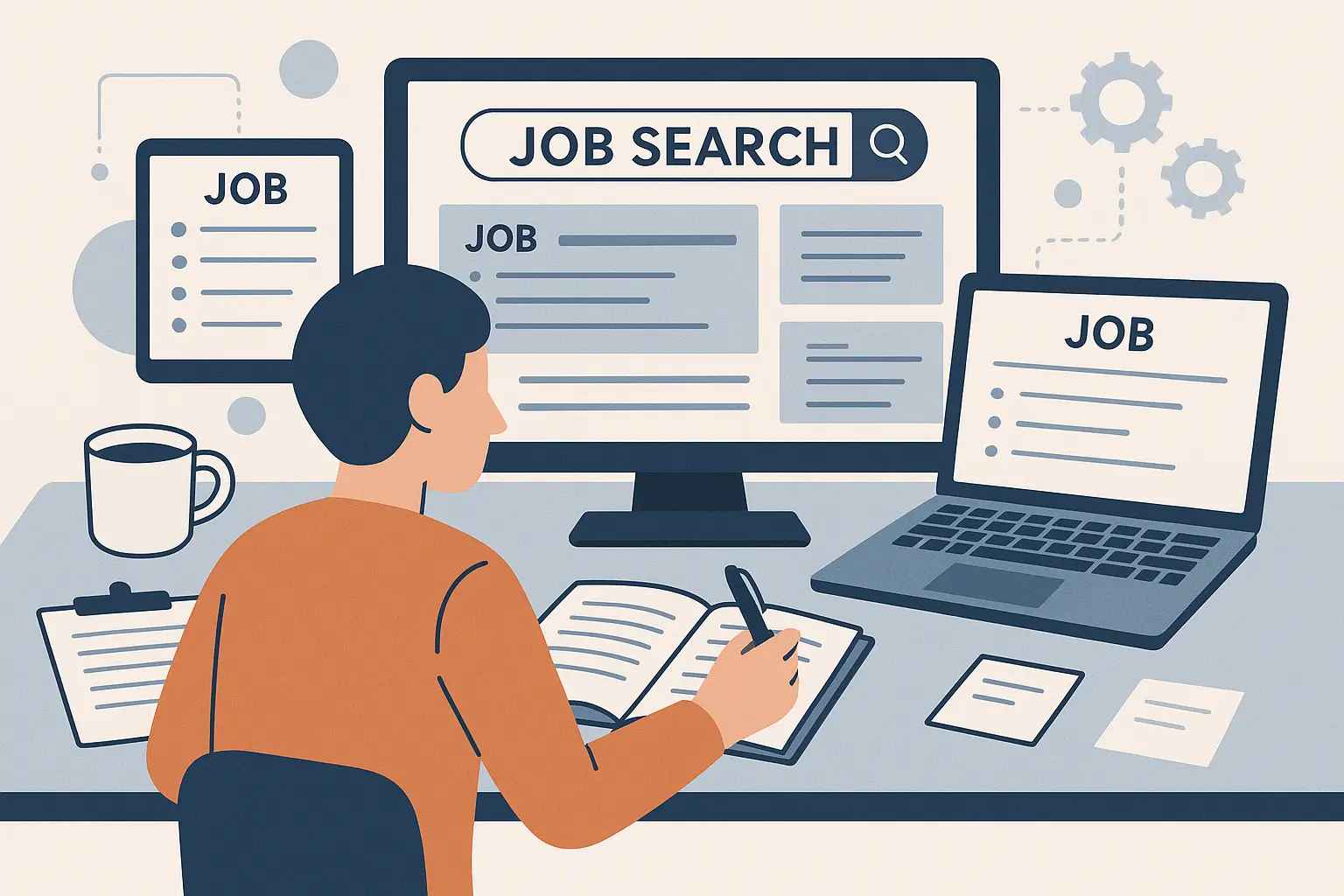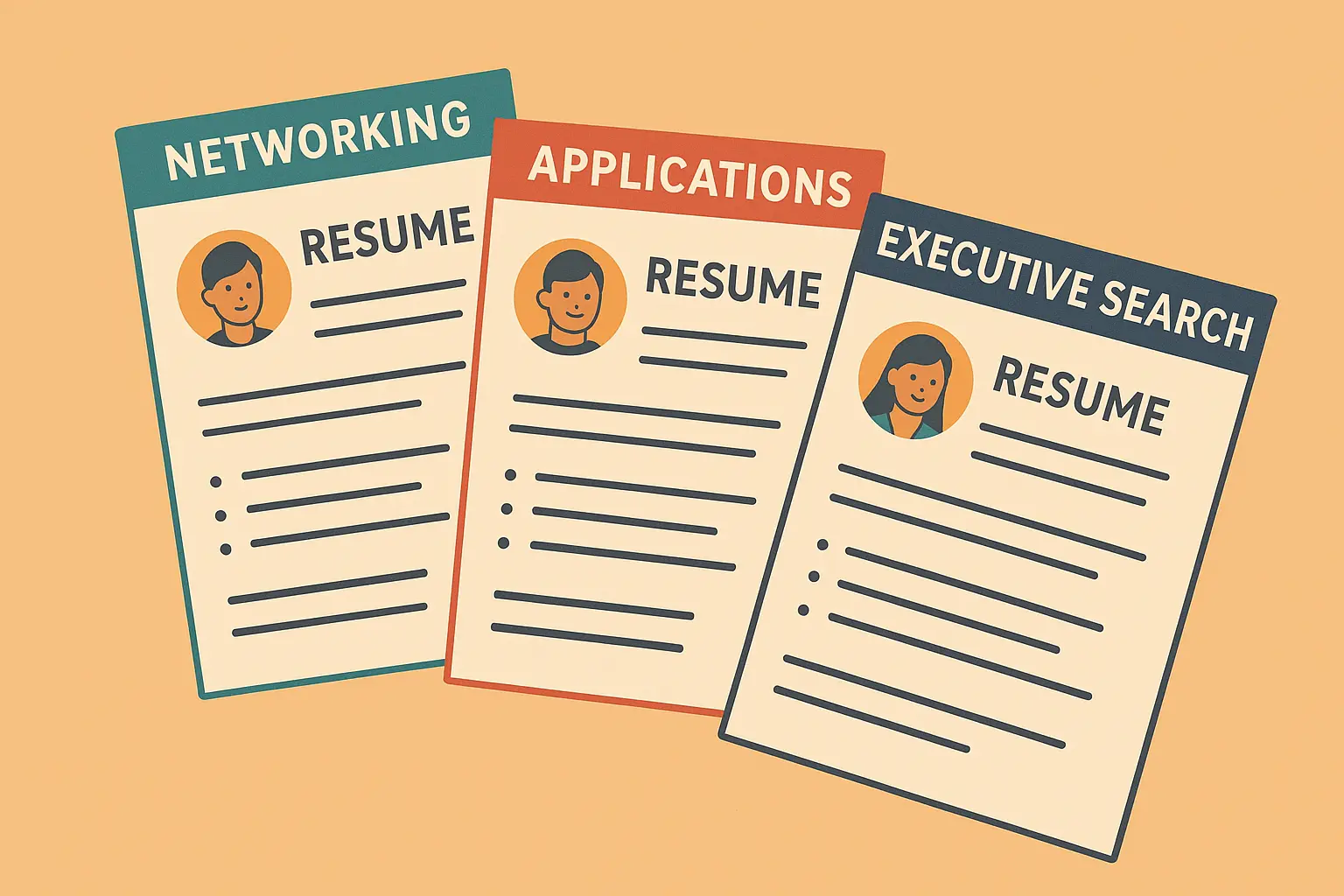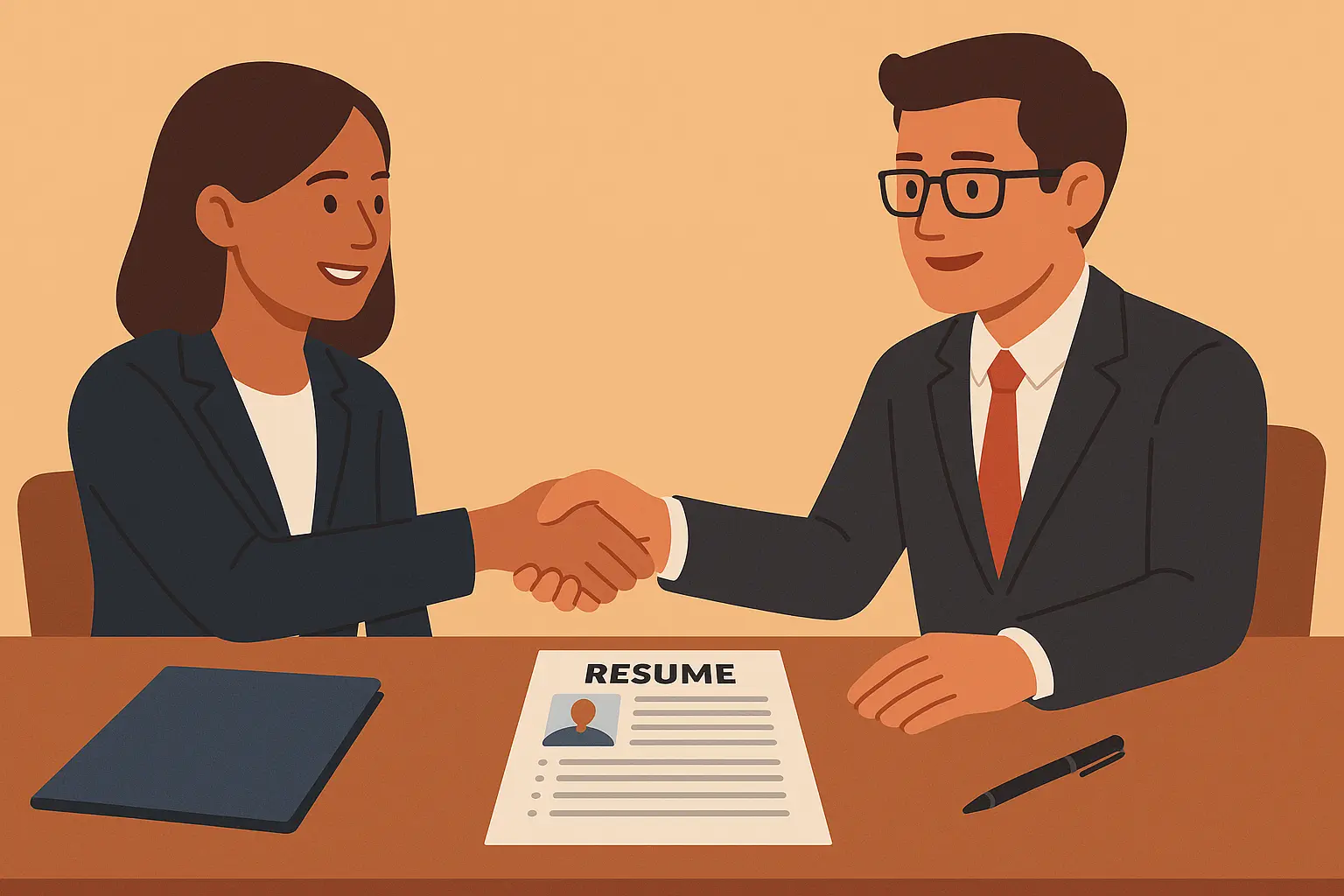How Long Should a Resume Be: The Truth About What Actually Gets You Hired

I’ve been helping people with their resumes for years, and here’s what drives me crazy: everyone’s obsessing over the wrong thing.
“Should my resume be one page or two?” they ask, while their actual content reads like a boring job description. Meanwhile, hiring managers are scanning hundreds of resumes looking for someone who can actually do the job.
Here’s the truth: recent research on over 125,000 resumes found that “77% of resumes were outside of that range” (Cultivated Culture) of the optimal 475-600 word count. But here’s what that research doesn’t tell you – it’s not really about the word count. So instead of asking ‘how long should a resume be,’ the smarter question is whether each word earns its place. It’s about whether every single word on that page makes the case for why you’re the right person for the job.
This guide breaks down the real factors that determine optimal resume length, from your career stage to industry expectations, helping you make strategic decisions that land interviews rather than following outdated rules.
Table of Contents
- Why the “One Page Only” Rule is Dead (And What Actually Matters Now)
- Your Experience Level Trumps Everything Else
- Here’s What Actually Matters: Every Word Must Earn Its Place
- The Step-by-Step Process to Get Your Length Right
- The Bottom Line: Stop Counting Pages, Start Telling Your Story
TL;DR
- The one-page resume rule died with paper applications – modern hiring is way more flexible
- Your career stage matters more than arbitrary page limits: new grads stick to one page, mid-career can expand to two
- Industry expectations vary dramatically – tech roles need project details while corporate positions prefer brevity
- ATS systems handle longer resumes just fine, so focus on content quality over length restrictions
- Every piece of information should earn its place through relevance and measurable impact
- Strategic editing beats random cutting – audit your content systematically
Why the “One Page Only” Rule is Dead (And What Actually Matters Now)
That one-page rule? It came from the days when recruiters literally had to stuff paper resumes into filing cabinets. Try fitting 200 resumes in a folder and you’ll understand why they wanted them short.
But we’re not printing resumes anymore. Today, the real debate isn’t how long should a resume be, but how clearly it communicates your value. Hiring managers read them on screens, search for keywords, and store everything digitally. The physical constraints that created the one-page rule simply don’t exist.
That said – and this is important – sometimes one page is still your best bet:
- You’re just starting out: Fresh graduates and entry-level folks should stick to one page. You don’t have enough relevant experience to justify more space, and trying to fill two pages usually leads to fluff.
- You’re changing careers: When you’re pivoting industries, less is more. You want hiring managers focused on your transferable skills, not confused by your unrelated background.
- The company culture demands it: Some traditional industries (think law firms or conservative corporations) still prefer concise resumes as a sign of good judgment.
Understanding modern resume formatting is crucial, and our comprehensive guide on professional resume format explains how to structure your content effectively regardless of length.
Industry Standards That Actually Matter
Different sectors have evolved distinct expectations around resume length based on how they evaluate candidates and what information they prioritize. Ignoring these differences can hurt your chances before you even get an interview.
If you’ve ever wondered how long should a resume be, the truth is it depends heavily on your industry.
| Industry | Preferred Length | Key Focus Areas | Special Considerations |
|---|---|---|---|
| Corporate/Business | 1-2 pages | Strategic achievements, leadership impact | Brevity demonstrates executive judgment |
| Technology | 2-3 pages | Technical skills, project details, metrics | Complex projects require detailed explanations |
| Academic/Research | 3+ pages (CV format) | Publications, grants, presentations | Comprehensive documentation expected |
| Healthcare | 1-2 pages | Certifications, clinical experience | Regulatory compliance focus |
| Creative | 1-2 pages + portfolio | Creative achievements, campaign results | Visual work shown separately |
Corporate finance roles prefer executives who can synthesize complex information quickly. If you can’t make your case in 1-2 pages, they’ll question your business judgment.
Tech companies want to see your projects in detail. Don’t just say “built an app” – tell them the tech stack, the user base, the problem you solved. Two pages is normal here.
Healthcare positions need to see your certifications, clinical experience, and compliance knowledge. But they also value efficiency. Stick to what’s relevant for the specific role.
Academia is its own beast entirely. For professionals considering the differences between these formats, our detailed analysis of CV vs resume job seekers mistakes clarifies when each format is appropriate and how length expectations differ between them.
Recent developments in federal employment transitions highlight how technical skills documentation varies between sectors. According to “Federal resumes tend to be lengthy because they are written to meet the criteria of USAJOBS. Private sector resumes should be results-oriented and tailored to the specific job for which you are applying. Resumes should be no more than two pages” (Partnership for Public Service), demonstrating how different employment sectors require dramatically different approaches.
What Technology Really Means for Resume Length
All those ATS horror stories you’ve heard? Most of them are outdated. Modern applicant tracking systems handle multi-page resumes just fine. The real ATS optimization isn’t about length – it’s about formatting and keywords. This means the old worry of how long should a resume be is mostly irrelevant to modern ATS systems.
What actually matters for ATS:
- Use standard fonts (Arial, Calibri, Times New Roman)
- Avoid graphics, tables, and fancy formatting
- Include keywords from the job posting naturally
- Save as a .docx file unless they specifically request PDF
What doesn’t matter:
- Whether your resume is 1, 2, or 3 pages
- Exact word count
- Page breaks or formatting across pages
The ATS will parse your content regardless of length. Focus on making it readable for humans, not gaming the system. To ensure your resume performs well regardless of length, understanding ATS friendly resume secrets will help you optimize for applicant tracking systems while maintaining the appropriate length for your career stage.
Your Experience Level Trumps Everything Else
Forget arbitrary rules. Your career stage should drive your resume length, period.
New Grad? One Page, Maximum Impact
If you’ve got less than 3 years of experience, keep it to one page. I know it feels limiting, but here’s the thing – you’re competing against people with similar experience levels. The winner isn’t who writes the most; it’s who presents their limited experience most compellingly.
Real example: Instead of listing “Responsible for social media management,” try “Increased Instagram engagement 67% in 4 months by creating weekly content calendars and engaging with followers daily.” Same experience, way more impact.
Entry-Level Strategy Checklist:
- Keep to one page maximum
- Lead with education if GPA is 3.5 or higher
- Quantify internship and project achievements
- Include relevant coursework and academic projects
- Highlight transferable skills from part-time work
- Use action verbs to start each bullet point
- Include 2-3 relevant extracurricular activities
Career changers face unique challenges because they must highlight transferable skills while de-emphasizing irrelevant experience. This often means using a one-page format to force prioritization of the most relevant qualifications.
Mid-Career Sweet Spot: Two Pages
Once you hit that 5-15 year range, you’ve earned the right to expand. You’ve got real accomplishments, leadership experience, and measurable results. Two pages gives you room to tell that story properly.
But here’s the catch – both pages need to work hard. Don’t just add filler because you have space. Every bullet point should make hiring managers think, “I need to meet this person.”
Research shows that only “26% of resumes included at least five instances of measurable results, metrics, or value and 36% of resumes had zero instances of metrics” (Cultivated Culture), highlighting a major opportunity for mid-career professionals to differentiate themselves through quantified achievements.
Instead of writing “Managed social media campaigns,” a mid-career marketing manager should expand to “Led integrated social media campaigns across 5 platforms, increasing brand engagement 78% and driving $2.3M in attributed revenue over 18 months while managing a $500K annual budget and team of 4 specialists.”
Senior Level: Whatever It Takes
Executives and senior leaders often need 2-3 pages, and that’s fine. At this level, you’re not just doing tasks – you’re setting strategy, leading teams, and driving organizational change. That complexity requires space to explain properly.
Just remember: longer doesn’t mean better. It means more responsibility to keep every section relevant and compelling.
Senior-level resumes benefit from expanded executive summaries that can span multiple paragraphs to capture leadership philosophy, strategic vision, and high-level accomplishments. This section becomes crucial for demonstrating your ability to think strategically and communicate complex ideas clearly.
Here’s What Actually Matters: Every Word Must Earn Its Place
I’ve reviewed thousands of resumes, and the best ones have one thing in common: every single line serves a purpose. It doesn’t matter if it’s one page or three – if something doesn’t make the case for hiring you, it shouldn’t be there.
Ask yourself these questions about every bullet point:
- Does this relate directly to jobs I want?
- Can I prove this with numbers or specific examples?
- Would a hiring manager care about this?
- Does this show I can solve their problems?
If you answer “no” to any of these, cut it. Be ruthless.
Instead of: “Managed team projects and improved efficiency”
Try: “Led 8-person product team through 3 major releases, reducing time-to-market by 40% and increasing customer satisfaction scores from 3.2 to 4.6”
See the difference? The second version tells a story with proof.
The Relevance Filter System
Every piece of resume content should pass through a relevance filter that evaluates its contribution to your target role. This systematic approach helps you determine which experiences deserve detailed coverage and which can be summarized or eliminated entirely.
Content Relevance Assessment:
- High Priority (Detailed Coverage): Direct role match, quantifiable results, recent experience
- Medium Priority (Brief Mention): Transferable skills, relevant but older experience, supporting qualifications
- Low Priority (Consider Removing): Unrelated experience, outdated skills, redundant information
Effective decisions start with careful analysis of job postings to understand what employers prioritize most. Map your experiences to specific job requirements, identifying which accomplishments best demonstrate your fit for the role.
ROI-Based Content Decisions
Evaluate each resume section based on its return on investment in terms of reader attention and hiring manager interest. High-impact achievements that demonstrate clear business value deserve detailed coverage, while routine responsibilities can be summarized briefly or eliminated.
Professional presentation matters regardless of length, which is why choosing the best resume fonts can enhance readability and make your content more impactful at any page count.
The Step-by-Step Process to Get Your Length Right
Look, all this theory is nice, but you probably just want to know: “What do I actually DO with my resume right now?” Here’s your game plan.
Step 1: Dump Everything Out (Yes, Everything)
Start by writing down every job, project, volunteer gig, and accomplishment from the last 10-15 years. Don’t worry about length yet – just get it all on paper. This isn’t your final resume; it’s your raw material.
I had a client who was convinced she “didn’t have enough experience” for a marketing director role. After this brain dump, we found she’d managed budgets, led teams, and launched campaigns across three different companies. She just hadn’t connected the dots.
Data shows that “candidates only included 51% of relevant keywords in their resume (with a 60% match rate for hard skills and only a 28% match rate for soft skills)” (Cultivated Culture), emphasizing the importance of thorough content auditing to ensure your resume includes the right keywords and skills regardless of length.
Step 2: Play Detective with Job Postings
Pull up 5-10 job postings for roles you actually want. Not dream jobs, not “maybe someday” positions – jobs you’d apply for next week.
What words keep showing up? What skills do they mention repeatedly? What problems are they trying to solve? This becomes your filter for what stays and what goes.
Pro tip: If a requirement shows up in 80% of your target jobs, it better be prominently featured on your resume, regardless of page count.
Step 3: The Brutal Edit
Now comes the hard part. Go through your brain dump and ask:
- “Does this directly relate to my target jobs?”
- “Can I prove this with numbers?”
- “Would this make a hiring manager want to call me?”
Be honest. That retail job from 2015? Probably not relevant for your software engineering career. The volunteer work where you organized events for 200+ people? That shows leadership – keep it.
Step 4: Test Drive Your Length
Print out your resume (yes, actually print it) and hand it to someone who doesn’t know your career history. Give them 30 seconds to scan it, then ask: “What do you think this person does, and are they good at it?”
If they’re confused or overwhelmed, you need to cut more. If they “get it” immediately, you’ve found your sweet spot. This is the most practical way to answer the question, how long should a resume be, for your unique situation.
Strategic Editing for Different Career Stages
Professional editing involves more than just cutting or adding content – it requires strategic thinking about how to present your background most effectively.
| Career Stage | Expansion Strategy | Condensation Strategy | Key Focus |
|---|---|---|---|
| Entry-Level (0-3 years) | Add project details, quantify internships, include relevant coursework | Remove irrelevant part-time jobs, consolidate similar experiences | Demonstrate potential and readiness |
| Mid-Career (3-10 years) | Expand on leadership roles, add context to achievements | Remove early career details, focus on recent 7-10 years | Show progression and impact |
| Senior-Level (10+ years) | Detail strategic initiatives, expand executive summary | Summarize early roles, group similar positions | Emphasize leadership and vision |
| Career Changer | Highlight transferable skills, expand relevant projects | Minimize unrelated experience, focus on applicable skills | Bridge gap to new industry |
A senior marketing director with 15 years of experience should condense their first three marketing coordinator roles into an “Early Career Experience” section with just company names, titles, and dates, while dedicating detailed bullet points to their last two director-level positions where they “launched 12 product campaigns generating $45M in revenue” and “built and led cross-functional teams of 25+ professionals.”
The changing landscape of career transitions is evident in current federal employee guidance, where experts recommend that “Mirror your resume to the job description using the same keywords. Focus on problems you helped solve” (Partnership for Public Service), highlighting how strategic editing must align with target role requirements regardless of your background complexity.
The Multi-Version Strategy That Actually Works
Here’s something most career advice gets wrong: you don’t need one perfect resume. You need a few good ones for different situations.
Your “Networking” Version (1 page): Clean , concise, conversation-starter. Perfect for career fairs, networking events, or when someone asks you to “send over your resume.”
Your “Application” Version (1-2 pages): Tailored for specific job applications. Keywords from the job posting, detailed achievements, optimized for ATS systems.
Your “Executive Search” Version (2-3 pages): For recruiters and high-level positions. Includes strategic vision, leadership philosophy, and comprehensive accomplishments.
Don’t overthink this. Most people need just two versions: a concise networking resume and a detailed application resume.
When creating multiple versions, leveraging the best resume builders can streamline the process and ensure consistent formatting across different length variations.
Multi-Version Resume Framework:
- Networking Version (1 page): Essential highlights only, focus on conversation starters
- Standard Application (1-2 pages): Comprehensive but focused, industry-appropriate length
- Executive Search (2-3 pages): Detailed strategic accomplishments, leadership philosophy
- Industry-Specific: Tailored content and keywords for specific sectors
- ATS-Optimized: Keyword-heavy version for online applications
Real Talk: Common Length Mistakes I See All the Time
Mistake #1: Padding for Length
I’ve seen one-page resumes stretched to two pages with white space, larger fonts, and irrelevant details. If you’re adding fluff just to hit two pages, stop. A strong one-page resume beats a weak two-page resume every single time.
Mistake #2: Cramming Everything Into One Page
On the flip side, I’ve seen senior managers try to squeeze 15 years of experience into tiny fonts and microscopic margins. If hiring managers need a magnifying glass to read your resume, you’ve lost them.
Mistake #3: The “Everything’s Important” Trap
Your first job out of college taught you valuable lessons, sure. But if you’re now a VP of Sales, those entry-level customer service achievements aren’t making your case. Focus on what matters now, not what mattered then.
The Bottom Line: Stop Counting Pages, Start Telling Your Story
Look, I get it. Rules feel safe. “One page good, two pages bad” is simple to follow. But hiring isn’t simple, and neither is your career.
The best resume length is whatever it takes to show hiring managers you’re exactly what they need. Sometimes that’s one page of laser-focused achievements. Sometimes it’s two pages of detailed leadership experience. Occasionally, it’s three pages of complex technical projects.
What matters is this: when someone finishes reading your resume, they should think, “This person gets it. They can do this job.” Whether that realization happens on page one or page three is irrelevant.
I’ve seen one-page resumes that got people hired for six-figure roles. I’ve also seen three-page resumes that landed executive positions. The difference wasn’t the length – it was the quality of the story they told.
So stop stressing about page counts and start focusing on impact. Tell your professional story clearly, back it up with results, and let the quality of your content speak for itself.
Your resume should be exactly long enough to demonstrate that you understand the job, you’ve solved similar problems before, and you can deliver results. Whether that takes one page or three doesn’t matter to hiring managers who are looking for solutions to their problems.
At the end of the day, the answer to how long should a resume be is simple: just long enough to prove you’re the right person for the job. Trust the process, focus on impact over page count, and remember: the best resume length is the one that gets you the interview.

